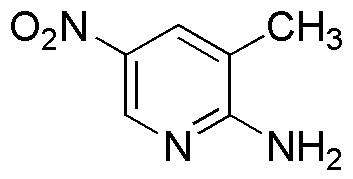2-Amino-3-methyl-5-nitropyridine is widely utilized in research focused on:
- Pharmaceutical Development: This compound serves as a key intermediate in the synthesis of various pharmaceuticals, particularly those targeting neurological disorders, enhancing drug efficacy and specificity.
- Agricultural Chemicals: It is used in the formulation of agrochemicals, contributing to the development of effective pesticides and herbicides that help in crop protection and yield improvement.
- Material Science: The compound is explored in the creation of advanced materials, including polymers and coatings, which offer improved durability and resistance to environmental factors.
- Analytical Chemistry: It acts as a reagent in analytical techniques, facilitating the detection and quantification of other chemical substances in complex mixtures.
- Research in Organic Chemistry: This chemical is employed in various organic synthesis reactions, enabling researchers to explore new pathways and develop innovative compounds with potential applications in multiple fields.
General Information
Properties
Safety and Regulations
Applications
2-Amino-3-methyl-5-nitropyridine is widely utilized in research focused on:
- Pharmaceutical Development: This compound serves as a key intermediate in the synthesis of various pharmaceuticals, particularly those targeting neurological disorders, enhancing drug efficacy and specificity.
- Agricultural Chemicals: It is used in the formulation of agrochemicals, contributing to the development of effective pesticides and herbicides that help in crop protection and yield improvement.
- Material Science: The compound is explored in the creation of advanced materials, including polymers and coatings, which offer improved durability and resistance to environmental factors.
- Analytical Chemistry: It acts as a reagent in analytical techniques, facilitating the detection and quantification of other chemical substances in complex mixtures.
- Research in Organic Chemistry: This chemical is employed in various organic synthesis reactions, enabling researchers to explore new pathways and develop innovative compounds with potential applications in multiple fields.
Documents
Safety Data Sheets (SDS)
The SDS provides comprehensive safety information on handling, storage, and disposal of the product.
Product Specification (PS)
The PS provides a comprehensive breakdown of the product’s properties, including chemical composition, physical state, purity, and storage requirements. It also details acceptable quality ranges and the product's intended applications.
Certificates of Analysis (COA)
Search for Certificates of Analysis (COA) by entering the products Lot Number. Lot and Batch Numbers can be found on a product’s label following the words ‘Lot’ or ‘Batch’.
Número de catálogo
Número de lote/lote
Certificates Of Origin (COO)
This COO confirms the country where the product was manufactured, and also details the materials and components used in it and whether it is derived from natural, synthetic, or other specific sources. This certificate may be required for customs, trade, and regulatory compliance.
Número de catálogo
Número de lote/lote
Safety Data Sheets (SDS)
The SDS provides comprehensive safety information on handling, storage, and disposal of the product.
DownloadProduct Specification (PS)
The PS provides a comprehensive breakdown of the product’s properties, including chemical composition, physical state, purity, and storage requirements. It also details acceptable quality ranges and the product's intended applications.
DownloadCertificates of Analysis (COA)
Search for Certificates of Analysis (COA) by entering the products Lot Number. Lot and Batch Numbers can be found on a product’s label following the words ‘Lot’ or ‘Batch’.
Número de catálogo
Número de lote/lote
Certificates Of Origin (COO)
This COO confirms the country where the product was manufactured, and also details the materials and components used in it and whether it is derived from natural, synthetic, or other specific sources. This certificate may be required for customs, trade, and regulatory compliance.


